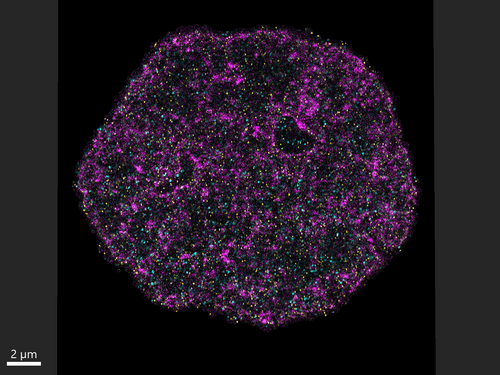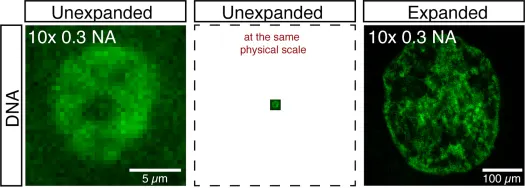
The ability to turn genes on or off is fundamental to the diversity we see in cells, in individuals, and even in terms of health and disease. This process, known as gene transcription, involves converting the information stored in our DNA into a “carbon copy” called RNA. Until recently, scientists have relied on inexact illustrations and indirect experiments to understand this process, as it occurs on a molecular level and is not directly visible. However, a breakthrough microscopy technique now enables researchers to observe previously unseen molecular processes within genetic material, providing valuable insights into how genes are activated and regulated.
Antonio Giraldez, PhD, Fergus F. Wallace Professor of Genetics at Yale School of Medicine, studies DNA codes in the genome and how cells interpret these codes to make an embryo. A crucial aspect of comprehending these processes involves our ability to visualize the genome. Unfortunately, traditional microscopy methods have limitations. To overcome these constraints, Giraldez and his colleagues, including the study’s first author, PhD candidate Mark Pownall, collaborated with Joerg Bewersdorf, PhD, Harvey and Kate Cushing Professor of Cell Biology and professor of biomedical engineering and of physics—and a renowned expert in microscopy—to develop a new technique called chromatin expansion microscopy (ChromExM).
In a paper published online in Science on July 6. they demonstrate its success in increasing the physical volume of the nuclei of zebrafish embryonic cells 4,000-fold to drastically improve image resolution. The technique allowed researchers to see for the first time how individual molecules shape gene expression in cells during embryonic development and to come up with a new model of how genes are regulated.
“Our research allows us to see fundamental processes in the nucleus that are the basis for everything in life, from the making of an embryo to cancer,” says Giraldez. “We can see processes that we could only imagine before.”
Our research allows us to see fundamental processes in the nucleus that are the basis for everything in life, from the making of an embryo to cancer. We can see processes that we could only imagine before."
- Antonio Giraldez
After sperm fertilizes an egg, the genome is initially “silent,” says Giraldez. The fertilized egg must transform into a transient pluripotent stem cell, or a cell that can give rise to many different cell types, to develop a healthy embryo. Programming the ability of this cell to make other cells requires jump-starting the genome.
For years, Giraldez and his team have studied how the genome becomes activated. They have made significant strides, from identifying important players to learning which genes are turned on. “But we had never seen the genome activating for ourselves,” says Giraldez. “There is a difference between describing how things might be happening and actually witnessing how things are happening.”
Microscopy Technique ChromExM Helps Researchers Visualize Genome
In his previous work, Bewersdorf, who is co-senior author of the study, developed a technique called pan-ExM which involved anchoring cells to an expandable gel to enable visualization of cellular features with unprecedented resolution. As the gel expanded, it pulled the cell and the proteins within them apart while maintaining their spatial organization, until the cell was 64 times bigger in volume. Then, with a second gel, the team repeated the process so that the volume of the cells grew 4,000-fold. For this new study, the Giraldez and Bewersdorf labs collaborated to create ChromExM and applied it to embryos to visualize how genes are regulated. Now, each individual cell was about the size of an embryo. “We used a very conventional tool, a confocal microscope, which allowed us to get this incredible resolution of the molecular machinery of the cell when combined with ChromExM,” says Giraldez. “Even the most powerful microscopes could not visualize this.”
Photo by Giraldez Lab |
|
Before and AfterUnexpanded and expanded nuclei with the DNA fluorescently labelled and imaged with a 10x objective shows how ChromExM dramatically improves resolution. The middle panel shows the unexpanded nucleus at the same physical scale as the expanded nucleus, demonstrating the ~15x physical expansion factor achieved by ChromExM |
 |
The process, he explains, is like the toy eggs that expand into dinosaurs when placed in water. When the egg is first dropped into the glass, the dinosaur’s features are not yet visible. But as the toy grows, it transforms from something amorphous into a creature with detailed features. “That dinosaur has probably grown two or three times in size,” says Giraldez. “Now imagine that growth at a 4,000-fold scale.”
Through ChromExM, the team was able to see for the first time the fundamental processes of the genome in action. This allowed them to develop a new model of how genes are regulated, which they named “kiss-and-kick” to describe the transience of how the regulatory regions in the DNA called enhancers interact with the beginning of the gene (promoters) to trigger expression of the gene, and how the burst of transcription then separates the regulatory regions of the gene (or kicks away the enhancer) to pause expression. “It’s like going from the pixelated black-and-white cell phone screens of the eighties to the super high-definition, colorful big screens of today,” says Giraldez. “Our technique allowed us to see detail that was not possible before.”
With this new method, the team looks forward to examining hypotheses that until recently were untestable. For example, in addition to seeing fundamental molecular processes, they also hope to explore how different genes are switched on or off, how they are positioned with respect to other genes in the nucleus, and how mutations affect gene positions. Furthermore, while other microscopy techniques may be prohibitively expensive, ChromExM is accessible for most laboratories. “Our work will democratize a method to see how molecular processes happen within the nucleus, which will open up new areas of research,” says Giraldez.
The team now hopes to improve the resolution of its technique even further. While researchers are now able to visualize molecules interacting with the genome, they still can’t identify individual genes. “Imagine you are in space, and you take a picture of New York City. Before you could just see the island, but now you can see people in the city,” Giraldez explains. “But we still don’t know who these people are. If you think of those people as the genes we want to see, we next want a camera that will allow us to focus on individual people” This detail will allow scientists to understand the fundamental principles of how genes are turned on and off, broken, or repaired, and how mutations affect their function—all fundamental steps to understanding how our genes work in health and disease.
This story is taken from the Yale School of Medicine news story of July 6, 2023 by Isabella Backman. Please see below for the link to the original story, which includes the video "A 3D Visualization Using ChromExM", plus related links